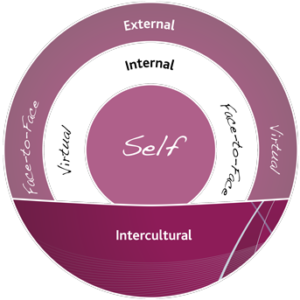Communication is a skill that you can learn. It’s like riding a bicycle or typing. If you’re willing to work at it, you can rapidly improve the quality of every part of your life.” – Brian Tracy
You will appreciate that even though communication skills are so important to success in the workplace and everywhere else, many individuals continue to struggle with it, unable to communicate their thoughts and ideas effectively – whether in verbal, non-verbal or written format. They struggle to convey their thoughts and ideas in an accurate manner, making it difficult to move forward and nearly impossible to collaborate. Things even get more complicated when communication happens between actors of different cultures, backgrounds, ages and digital means of communication.
 Communication is like a “two-way street”. And, it involves not only two, but three components:
Communication is like a “two-way street”. And, it involves not only two, but three components:
- A receptive element: Listening
- An expressive element: Speaking
- A primary element: Presence, self-awareness
We have to be HERE first if we’re going to communicate. Communication is a flow of understanding; presence helps to create a ground for connection, and provides an important tool for examining and re-training our communication patterns. Let’s just think about how often you communicate with people during your day: you write emails, facilitate meetings, participate in conference calls, create reports, devise presentations, debate with your colleagues… the list goes on!
Our intention when communicating, forms the basis of our orientation in any conversation. What we need to do is to understand our motivation: where are we coming from, what do we want to achieve while communicating? Without a clear and solid grounding and the intention to connect, to understand, we run the risk of using communication tools to simply repeat old habits of interacting. This foundation is a systematic training of our attention to notice four basic components of our experience, as taught in Nonviolent Communication:
- Observations: what we see/hear directly, separate from our evaluations or interpretations
- Feelings: our emotions, distinct from thoughts and stories about what others are doing
- Needs: fundamental, universal human needs or values; what matters most in a situation
- Requests: asking concretely and clearly for what might help move things forward
Did you know that :
The single most powerful and transformative ingredient in dialogue is the intention to understand?
The good news is, effective and mindful communication is a skill that can be practiced! In fact, habits of speaking, listening, and relating are learned. We have all had “communication training” by our family, our culture, our society, and our life experiences. But:
When our needs aren’t met, we have been conditioned to see things in terms of blame.
Internal thoughts of blame however can provide useful information about what really matters to us! If we want someone to do something differently, to listen to or understand us, how useful of a strategy is it to blame them? Well, not that useful, right? So here’s what to do:
- Principle 1: The less blame and criticism in our words, the more openness others will have to hear what’s going on for us and collaborate!
- Principle 2: How we are speaking can be as important as what we say. Bringing curiosity and care makes it easier to get to what we really want to talk about!
Up for a try? Thanks for reading and have a great week,
Jenny



